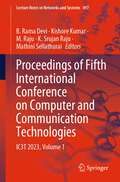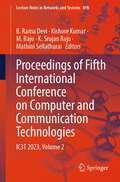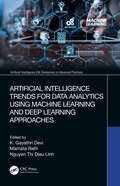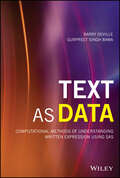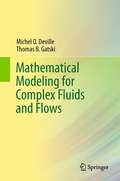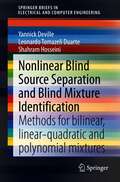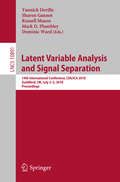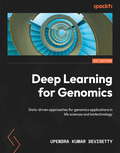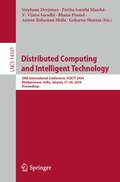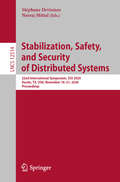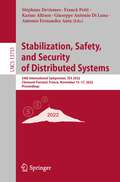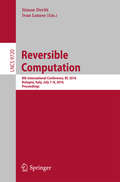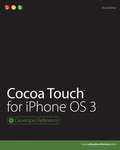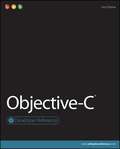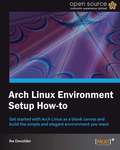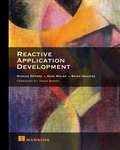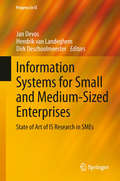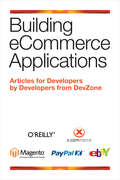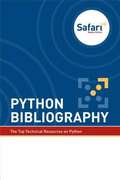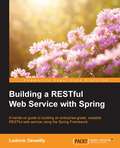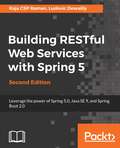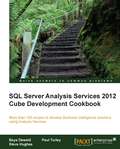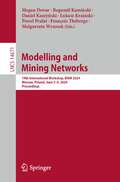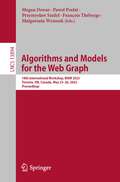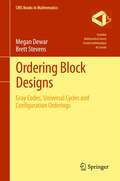- Table View
- List View
Proceedings of Fifth International Conference on Computer and Communication Technologies: IC3T 2023, Volume 1 (Lecture Notes in Networks and Systems #897)
by B. Rama Devi Kishore Kumar M. Raju K. Srujan Raju Mathini SellathuraiThis book is a compilation of high-quality scientific papers presented at the 5th International Conference on Computer & Communication Technologies (IC3T 2023). The book covers cutting-edge technologies and applications of soft computing, artificial intelligence and communication. In addition, a variety of further topics are discussed, which include data mining, machine intelligence, fuzzy computing, sensor networks, signal and image processing, human–computer interaction, and web intelligence.
Proceedings of Fifth International Conference on Computer and Communication Technologies: IC3T 2023, Volume 2 (Lecture Notes in Networks and Systems #898)
by B. Rama Devi Kishore Kumar M. Raju K. Srujan Raju Mathini SellathuraiThis book is a compilation of high-quality scientific papers presented at the 5th International Conference on Computer & Communication Technologies (IC3T 2023). The book covers cutting-edge technologies and applications of soft computing, artificial intelligence and communication. In addition, a variety of further topics are discussed, which include data mining, machine intelligence, fuzzy computing, sensor networks, signal and image processing, human–computer interaction, and web intelligence.
Artificial Intelligence Trends for Data Analytics Using Machine Learning and Deep Learning Approaches (Artificial Intelligence (AI): Elementary to Advanced Practices)
by K. Gayathri Devi Mamata Rath Nguyen Thi Dieu LinhArtificial Intelligence (AI), when incorporated with machine learning and deep learning algorithms, has a wide variety of applications today. This book focuses on the implementation of various elementary and advanced approaches in AI that can be used in various domains to solve real-time decision-making problems. The book focuses on concepts and techniques used to run tasks in an automated manner. It discusses computational intelligence in the detection and diagnosis of clinical and biomedical images, covers the automation of a system through machine learning and deep learning approaches, presents data analytics and mining for decision-support applications, and includes case-based reasoning, natural language processing, computer vision, and AI approaches in real-time applications. Academic scientists, researchers, and students in the various domains of computer science engineering, electronics and communication engineering, and information technology, as well as industrial engineers, biomedical engineers, and management, will find this book useful. By the end of this book, you will understand the fundamentals of AI. Various case studies will develop your adaptive thinking to solve real-time AI problems. Features Includes AI-based decision-making approaches Discusses computational intelligence in the detection and diagnosis of clinical and biomedical images Covers automation of systems through machine learning and deep learning approaches and its implications to the real world Presents data analytics and mining for decision-support applications Offers case-based reasoning
Text as Data: Computational Methods of Understanding Written Expression Using SAS (Wiley and SAS Business Series)
by Barry DeVille Gurpreet Singh BawaText As Data: Combining qualitative and quantitative algorithms within the SAS system for accurate, effective and understandable text analytics The need for powerful, accurate and increasingly automatic text analysis software in modern information technology has dramatically increased. Fields as diverse as financial management, fraud and cybercrime prevention, Pharmaceutical R&D, social media marketing, customer care, and health services are implementing more comprehensive text-inclusive, analytics strategies. Text as Data: Computational Methods of Understanding Written Expression Using SAS presents an overview of text analytics and the critical role SAS software plays in combining linguistic and quantitative algorithms in the evolution of this dynamic field. Drawing on over two decades of experience in text analytics, authors Barry deVille and Gurpreet Singh Bawa examine the evolution of text mining and cloud-based solutions, and the development of SAS Visual Text Analytics. By integrating quantitative data and textual analysis with advanced computer learning principles, the authors demonstrate the combined advantages of SAS compared to standard approaches, and show how approaching text as qualitative data within a quantitative analytics framework produces more detailed, accurate, and explanatory results. Understand the role of linguistics, machine learning, and multiple data sources in the text analytics workflow Understand how a range of quantitative algorithms and data representations reflect contextual effects to shape meaning and understanding Access online data and code repositories, videos, tutorials, and case studies Learn how SAS extends quantitative algorithms to produce expanded text analytics capabilities Redefine text in terms of data for more accurate analysis This book offers a thorough introduction to the framework and dynamics of text analytics—and the underlying principles at work—and provides an in-depth examination of the interplay between qualitative-linguistic and quantitative, data-driven aspects of data analysis. The treatment begins with a discussion on expression parsing and detection and provides insight into the core principles and practices of text parsing, theme, and topic detection. It includes advanced topics such as contextual effects in numeric and textual data manipulation, fine-tuning text meaning and disambiguation. As the first resource to leverage the power of SAS for text analytics, Text as Data is an essential resource for SAS users and data scientists in any industry or academic application.
Mathematical Modeling for Complex Fluids and Flows
by Michel Deville Thomas B. GatskiMathematical Modeling for Complex Fluids and Flows provides researchers and engineering practitioners encountering fluid flows with state-of-the-art knowledge in continuum concepts and associated fluid dynamics. In doing so it supplies the means to design mathematical models of these flows that adequately express the engineering physics involved. It exploits the implicit link between the turbulent flow of classical Newtonian fluids and the laminar and turbulent flow of non-Newtonian fluids such as those required in food processing and polymeric flows. The book develops a descriptive mathematical model articulated through continuum mechanics concepts for these non-Newtonian, viscoelastic fluids and turbulent flows. Each complex fluid and flow is examined in this continuum context as well as in combination with the turbulent flow of viscoelastic fluids. Some details are also explored via kinetic theory, especially viscoelastic fluids and their treatment with the Boltzmann equation. Both solution and modeling strategies for turbulent flows are laid out using continuum concepts, including a description of constructing polynomial representations and accounting for non-inertial and curvature effects. Ranging from fundamental concepts to practical methodology, and including discussion of emerging technologies, this book is ideal for those requiring a single-source assessment of current practice in this intricate yet vital field.
Nonlinear Blind Source Separation and Blind Mixture Identification: Methods for Bilinear, Linear-quadratic and Polynomial Mixtures (SpringerBriefs in Electrical and Computer Engineering)
by Yannick Deville Leonardo Tomazeli Duarte Shahram HosseiniThis book provides a detailed survey of the methods that were recently developed to handle advanced versions of the blind source separation problem, which involve several types of nonlinear mixtures. Another attractive feature of the book is that it is based on a coherent framework. More precisely, the authors first present a general procedure for developing blind source separation methods. Then, all reported methods are defined with respect to this procedure. This allows the reader not only to more easily follow the description of each method but also to see how these methods relate to one another. The coherence of this book also results from the fact that the same notations are used throughout the chapters for the quantities (source signals and so on) that are used in various methods. Finally, among the quite varied types of processing methods that are presented in this book, a significant part of this description is dedicated to methods based on artificial neural networks, especially recurrent ones, which are currently of high interest to the data analysis and machine learning community in general, beyond the more specific signal processing and blind source separation communities.
Latent Variable Analysis and Signal Separation: 14th International Conference, LVA/ICA 2018, Guildford, UK, July 2–5, 2018, Proceedings (Lecture Notes in Computer Science #10891)
by Yannick Deville Sharon Gannot Russell Mason Mark D. Plumbley Dominic WardThis book constitutes the proceedings of the 14th International Conference on Latent Variable Analysis and Signal Separation, LVA/ICA 2018, held in Guildford, UK, in July 2018.The 52 full papers were carefully reviewed and selected from 62 initial submissions. As research topics the papers encompass a wide range of general mixtures of latent variables models but also theories and tools drawn from a great variety of disciplines such as structured tensor decompositions and applications; matrix and tensor factorizations; ICA methods; nonlinear mixtures; audio data and methods; signal separation evaluation campaign; deep learning and data-driven methods; advances in phase retrieval and applications; sparsity-related methods; and biomedical data and methods.
Deep Learning for Genomics: Data-driven approaches for genomics applications in life sciences and biotechnology
by Upendra Kumar DevisettyLearn concepts, methodologies, and applications of deep learning for building predictive models from complex genomics data sets to overcome challenges in the life sciences and biotechnology industriesKey FeaturesApply deep learning algorithms to solve real-world problems in the field of genomicsExtract biological insights from deep learning models built from genomic datasetsTrain, tune, evaluate, deploy, and monitor deep learning models for enabling predictions in genomicsBook DescriptionDeep learning has shown remarkable promise in the field of genomics; however, there is a lack of a skilled deep learning workforce in this discipline. This book will help researchers and data scientists to stand out from the rest of the crowd and solve real-world problems in genomics by developing the necessary skill set. Starting with an introduction to the essential concepts, this book highlights the power of deep learning in handling big data in genomics. First, you'll learn about conventional genomics analysis, then transition to state-of-the-art machine learning-based genomics applications, and finally dive into deep learning approaches for genomics. The book covers all of the important deep learning algorithms commonly used by the research community and goes into the details of what they are, how they work, and their practical applications in genomics. The book dedicates an entire section to operationalizing deep learning models, which will provide the necessary hands-on tutorials for researchers and any deep learning practitioners to build, tune, interpret, deploy, evaluate, and monitor deep learning models from genomics big data sets. By the end of this book, you'll have learned about the challenges, best practices, and pitfalls of deep learning for genomics.What you will learnDiscover the machine learning applications for genomicsExplore deep learning concepts and methodologies for genomics applicationsUnderstand supervised deep learning algorithms for genomics applicationsGet to grips with unsupervised deep learning with autoencodersImprove deep learning models using generative modelsOperationalize deep learning models from genomics datasetsVisualize and interpret deep learning modelsUnderstand deep learning challenges, pitfalls, and best practicesWho this book is forThis deep learning book is for machine learning engineers, data scientists, and academicians practicing in the field of genomics. It assumes that readers have intermediate Python programming knowledge, basic knowledge of Python libraries such as NumPy and Pandas to manipulate and parse data, Matplotlib, and Seaborn for visualizing data, along with a base in genomics and genomic analysis concepts.
Distributed Computing and Intelligent Technology: 20th International Conference, ICDCIT 2024, Bhubaneswar, India, January 17–20, 2024, Proceedings (Lecture Notes in Computer Science #14501)
by Stéphane Devismes Partha Sarathi Mandal V. Vijaya Saradhi Bhanu Prasad Anisur Rahaman Molla Gokarna SharmaThis book constitutes the refereed proceedings of the 20th International Conference on Distributed Computing and Intelligent Technology, ICDCIT 2024, which was held in Bhubaneswar, India, during January 17–20, 2024. The 24 full papers presented in this volume were carefully reviewed and selected from 116 submissions. The papers are organized in the following topical sections: Distributed Computing (DC) and Intelligent Technology (IT). The DC track solicits original research papers contributing to the foundations and applications of distributed computing, whereas the IT track solicits original research papers contributing to the foundations and applications of Intelligent Technology.
Stabilization, Safety, and Security of Distributed Systems: 22nd International Symposium, SSS 2020, Austin, TX, USA, November 18–21, 2020, Proceedings (Lecture Notes in Computer Science #12514)
by Stéphane Devismes Neeraj MittalThis book constitutes the refereed proceedings of the 22nd International Symposium on Stabilization, Safety, and Security of Distributed Systems, SSS 2020, held in Austin, TX, USA, in November 2020.The 16 full papers, 7 short and 2 invited papers presented were carefully reviewed and selected from 44 submissions. The papers deal with the design and development of distributed systems with a focus on systems that are able to provide guarantees on their structure, performance, and/or security in the face of an adverse operational environment.
Stabilization, Safety, and Security of Distributed Systems: 24th International Symposium, SSS 2022, Clermont-Ferrand, France, November 15–17, 2022, Proceedings (Lecture Notes in Computer Science #13751)
by Stéphane Devismes Franck Petit Karine Altisen Giuseppe Antonio Di Luna Antonio Fernandez AntaThis book constitutes the proceedings of 24th International Symposium, SSS 2022, which took place in Clermont-Ferrand, France, in November 2022.The 17 regular papers together with 4 invited papers and 7 brief announcements, included in this volume were carefully reviewed and selected from 58 submissions. The SSS 2022 focus on systems built such that they are able to provide on their own guarantees on their structure, performance, and/or security in the face of an adverse environment. The Symposium presents three tracks reflecting major trends related to the conference: (i) Self-stabilizing Systems: Theory and Practice, (ii) Concurrent and Distributed Computing: Foundations, Faulttolerance, and Security, and (iii) Dynamic, Mobile, and Nature-Inspired Computing.
Reversible Computation
by Simon Devitt Ivan LaneseThis book constitutes the refereed proceedings of the 8th International Conference on Reversible Computation, RC 2016, held in Bologna, Italy, in July 2016. The 18 full and 5 short papers included in this volume were carefully reviewed and selected from 38 submissions. The papers are organized in topical sections named: process calculi; reversible models; programming languages; quantum computing; quantum programming; circuit theory; and syntheses.
Cocoa Touch for iPhone OS 3
by Jiva DevoeJoin the gold rush to developing cool iPhone apps with this complete iPhone OS 3 developer's guide. Professional developer Jiva DeVoe speaks your language, and he talks you through the entire process--from explaining Cocoa Touch and the iPhone SDK to using Xcode and the Game Kit API. Follow step-by-step tutorials, then apply practical tips on signing and selling your applications. Even if you're new to iPhone development you'll soon be cranking out great code. Walk through Xcode, Interface Builder, and other key toolsBuild simple or complex GUIs with navigation and custom viewsImplement a database with Core Data, and design your schema in XcodeLearn to use the iPhone's signature multi-touch capabilities in your applicationsWork with the Apple Push Notification ServiceUse the Map Kit API to create apps with embedded mapsRecord audio, play video, and access the iPod LibrarySet up your developer certificates and code sign your appsUse Store Kit to sell expanded features and content within your appsWhether you're a new iPhone developer or seasoned veteran, this book is the perfect go-to reference for iPhone development-and one of an exciting new series for Apple developers.Note: CD-ROM/DVD and other supplementary materials are not included as part of eBook file.
Objective-C
by Jiva DevoeA soup-to-nuts guide on the Objective-C programming languageObjective-C is the language behind Cocoa and Cocoa Touch, which is the Framework of applications written for the Macintosh, iPod touch, iPhone, and iPad platforms. Part of the Developer Reference series covering the hottest Apple topics, this book covers everything from the basics of the C language to advanced aspects of Apple development. You'll examine Objective-C and high-level subjects of frameworks, threading, networking, and much more.Covers the basics of the C language and then quickly moves onto Objective-C and more advanced topicsDraws from the author's first-hand experience garnered while developing applications for the Mac and iPhone OS platformsIncludes chapters on classes, memory management, threads, and the Foundation frameworkAlso covers advanced topics like protocols, categories, associated objects, and blocksFeaturing real-life examples drawn from the author's experience, Objective-C offers an insider look at this amazing programming language.
Arch Linux Environment Setup How-To
by Ike DevolderEach task expresses a specific task for setting up an Arch Linux environment. The recipe as a solution is a carefully organized set of instructions to perform the task as efficiently as possible and a discussion on how to apply the solution in different situations. "Arch Linux Environment Set-up" How to is for people wanting to dig deep into a Linux system. By the end of the book you will have basic knowledge how a Linux system is built up, how it boots and a general idea of how it is working. The book also assumes you already know what partitioning is and if you need dual booting you already have some experience with that. For people only trying out Arch Linux the author would suggest following this guide inside a virtual machine.
Reactive Application Development
by Duncan K. DeVore Sean A. WalshSummaryReactive Application Development is a hands-on guide that teaches you how to build reliable enterprise applications using reactive design patterns.Purchase of the print book includes a free eBook in PDF, Kindle, and ePub formats from Manning Publications.Foreword by Jonas Bonér, Creator of Akka About the TechnologyMission-critical applications have to respond instantly to changes in load, recover gracefully from failure, and satisfy exacting requirements for performance, cost, and reliability. That's no small task! Reactive designs make it easier to meet these demands through modular, message-driven architecture, innovative tooling, and cloud-based infrastructure.About the BookReactive Application Development teaches you how to build reliable enterprise applications using reactive design patterns. This hands-on guide begins by exposing you to the reactive mental model, along with a survey of core technologies like the Akka actors framework. Then, you'll build a proof-of-concept system in Scala, and learn to use patterns like CQRS and Event Sourcing. You'll master the principles of reactive design as you implement elasticity and resilience, integrate with traditional architectures, and learn powerful testing techniques.What's InsideDesigning elastic domain modelsBuilding fault-tolerant systemsEfficiently handling large data volumesExamples can be built in Scala or JavaAbout the Reader Written for Java or Scala programmers familiar with distributed application designs.About the AuthorDuncan DeVore, Sean Walsh, and Brian Hanafee are seasoned architects with experience building and deploying reactive systems in production. Table of ContentsPART 1 - FUNDAMENTALS What is a reactive application? Getting started with Akka Understanding Akka PART 2 - BUILDING A REACTIVE APPLICATION Mapping from domain to toolkit Domain-driven design Using remote actors Reactive streaming CQRS and Event Sourcing A reactive interfaceProduction readiness
Information Systems for Small and Medium-sized Enterprises
by Jan Devos Hendrik Landeghem Dirk DeschoolmeesterThis book establishes and explores existing and emerging theories on Small and Medium-sized Enterprises (SMEs) and the adoption of IT/IS. It presents the latest empirical research findings in that area of IS research and explores new technologies and practices. The book is written for researchers and professionals working in the field of IS research or the research of SMEs. Moreover, the book will be a reference for researchers, professionals and students in management information systems science and related fields.
Building eCommerce Applications
by Developers From Devzone<p>This collection of articles and blog entries is representative of the full spectrum of commerce-related content we’ve published on PayPal’s Developer Network over the past year. You will find tutorials and quick reference pieces for developers. With the creation of x.commerce we have expanded our coverage to address the needs of eBay and Magento developers and you can expect to see more content focused on helping both the developer and merchant communities in the coming year.<br/><br/>\nOur team has covered a wide variety of topics including building mobile shopping carts, QR codes, working with various PayPal APIs, including how to integrate PayPal with other technologies such as WordPress. Three main themes have emerged in the commerce world today: Mobile, Social, and Local. Expect to see more coverage of these in the coming months.</p>
Python Bibliography
by Developers From DevzoneTwenty years ago, Guido van Rossum was hard at work on the first release of Python. A lot has changed in those twenty years. Many of the programming languages that were contemporaries of Python have started showing their age. Meanwhile, there have been no shortages of new programming languages, yet Python continues to hold up well. Its emphasis on clean syntax, and its melding of object-oriented and functional programming elements, put it years ahead of the other popular languages from the 1990s. The story of Python is not only about it being ahead of its time in terms of syntax and features. It is also about its open development and the community around it. Its value as a scripting language is well known, and it ships with many operating systems. For years Python has been one of the Pâ TMs in the LAMP stack used for numerous web applications. Indeed, Pythonâ TMs popularity with web developers has lead to a multitude of web application frameworks written in Python: Django, TurboGears, Pylons, CherryPy, and so on. Even with technology's fast-moving pace, Python remains on the cutting edge. NoSQL data stores have become increasingly popular, and you can find first class support for using Python with any of these technologies. This is just further evidence of the continued popularity of Python and the vibrant community around it. This bibliography contains a wide selection of books about Python. These range from various introductory to advanced books. Of course, web development is covered, but you might be surprised to see the wide variety of other types of development that are done using Python. Whether you are working on machine learning or just hacking in your spare time, Python has something for you.
Building a RESTful Web Service with Spring
by Ludovic DewaillyA hands-on guide to building an enterprise-grade, scalable RESTful web service using the Spring Framework About This Book * Follow best practices and explore techniques such as clustering and caching to achieve a scalable web service * Leverage the Spring Framework to quickly implement RESTful endpoints * Learn to implement a client library for a RESTful web service using the Spring Framework Who This Book Is For This book is intended for those who want to learn to build RESTful web services with the Spring Framework. To make best use of the code samples included in the book, you should have a basic knowledge of the Java language. Previous experience with the Spring Framework would also help you get up and running quickly. What You Will Learn * Deep dive into the principles behind REST * Expose CRUD operations through RESTful endpoints with the Spring Framework * Devise response formats and error handling strategies, offering a consistent and flexible structure to simplify integration for service consumers * Follow the best approaches for dealing with a service's evolution while maintaining backward compatibility * Understand techniques to secure web services * Comply with the best ways to test RESTful web services, including tips for load testing * Optimise and scale web services using techniques such as caching and clustering In Detail REST is an architectural style that tackles the challenges of building scalable web services. In today's connected world, APIs have taken a central role on the web. APIs provide the fabric through which systems interact, and REST has become synonymous with APIs. The depth, breadth, and ease of use of Spring makes it one of the most attractive frameworks in the Java ecosystem. Marrying the two technologies is therefore a very natural choice. This book takes you through the design of RESTful web services and leverages the Spring Framework to implement these services. Starting from the basics of the philosophy behind REST, you'll go through the steps of designing and implementing an enterprise-grade RESTful web service. Taking a practical approach, each chapter provides code samples that you can apply to your own circumstances. This book goes beyond the use of Spring and explores approaches to tackle resilience, security, and scalability concerns. You'll learn techniques to deal with security in Spring and discover how to implement unit and integration test strategies. Finally, the book ends by walking you through building a Java client for your RESTful web service, along with some scaling techniques for it. Style and approach This book is a step-by-step, hands-on guide to designing and building RESTful web services. The book follows the natural cycle of developing these services and includes multiple code samples to help you.
Building RESTful Web Services with Spring 5: Leverage the power of Spring 5.0, Java SE 9, and Spring Boot 2.0
by Ludovic Dewailly Raja Csp RamanFind out how to implement the REST architecture to build resilient software in Java with the help of the Spring 5.0 framework. Key Features ~Follow best practices and explore techniques such as clustering and caching to achieve a reactive, scalable web service,~Leverage the Spring Framework to quickly implement RESTful endpoints,~Learn to implement a client library for a RESTful web service using the Spring Framework along with the new front end framework. Book Description REST is an architectural style that tackles the challenges of building scalable web services. In today's connected world, APIs have taken a central role on the web. APIs provide the fabric through which systems interact, and REST has become synonymous with APIs.The depth, breadth, and ease of use of Spring makes it one of the most attractive frameworks in the Java ecosystem. Marrying the two technologies is therefore a very natural choice.This book takes you through the design of RESTful web services and leverages the Spring Framework to implement these services. Starting from the basics of the philosophy behind REST, you'll go through the steps of designing and implementing an enterprise-grade RESTful web service. Taking a practical approach, each chapter provides code samples that you can apply to your own circumstances.This second edition brings forth the power of the latest Spring 5.0 release, working with MVC built-in as well as the front end framework. It then goes beyond the use of Spring to explores approaches to tackle resilience, security, and scalability concerns. Improve performance of your applications with the new HTTP 2.0 standards. You'll learn techniques to deal with security in Spring and discover how to implement unit and integration test strategies.Finally, the book ends by walking you through building a Java client for your RESTful web service, along with some scaling techniques using the new Spring Reactive libraries. What you will learn Deep dive into the principles behind REST Expose CRUD operations through RESTful endpoints with the Spring Framework Devise response formats and error handling strategies, offering a consistent and flexible structure to simplify integration for service consumers Follow the best approaches for dealing with a service's evolution while maintaining backward compatibility Understand techniques to secure web services Comply with the best ways to test RESTful web services, including tips for load testing Optimise and scale web services using techniques such as caching and clustering Who this book is for This book is intended for those who want to learn to build RESTful web services with the latest Spring 5.0 Framework. To make best use of the code samples included in the book, you should have a basic knowledge of the Java language. Previous experience with the Spring Framework would also help you get up and running quickly.
SQL Server Analysis Services 2012 Cube Development Cookbook
by Baya Dewald Paul Turley Steve HughesA practical cookbook packed with recipes to help developers produce data cubes as quickly as possible by following step by step instructions, rather than explaining data mining concepts with SSAS.If you are a BI or ETL developer using SQL Server Analysis services to build OLAP cubes, this book is ideal for you. Prior knowledge of relational databases and experience with Excel as well as SQL development is required.
Modelling and Mining Networks: 19th International Workshop, WAW 2024, Warsaw, Poland, June 3–6, 2024, Proceedings (Lecture Notes in Computer Science #14671)
by Megan Dewar Bogumił Kamiński Daniel Kaszyński Łukasz Kraiński Paweł Prałat François Théberge Małgorzata WrzosekThis book constitutes the refereed proceedings of the 19th International Workshop on Modelling and Mining Networks, WAW 2024, held in Warsaw, Poland, during June 3–6, 2024. The 12 full papers presented in this book were carefully reviewed and selected from 19 submissions. The aim of this workshop was to further the understanding of networks that arise in theoretical as well as applied domains. The goal was also to stimulate the development of high-performance and scalable algorithms that exploit these networks.
Algorithms and Models for the Web Graph: 18th International Workshop, WAW 2023, Toronto, ON, Canada, May 23–26, 2023, Proceedings (Lecture Notes in Computer Science #13894)
by Megan Dewar Paweł Prałat Przemysław Szufel François Théberge Małgorzata WrzosekThis book constitutes the proceedings of the 18th International Workshop on Algorithms and Models for the Web Graph, WAW 2023, held in Toronto, Canada, in May 23–26, 2023.The 12 Papers presented in this volume were carefully reviewed and selected from 21 submissions. The aim of the workshop was understanding of graphs that arise from the Web and various user activities on the Web, and stimulate the development of high-performance algorithms and applications that exploit these graphs.
Ordering Block Designs
by Megan Dewar Brett StevensThe study of combinatorial block designs is a vibrant area of combinatorial mathematics with connections to finite geometries, graph theory, coding theory and statistics. The practice of ordering combinatorial objects can trace its roots to bell ringing which originated in 17th century England, but only emerged as a significant modern research area with the work of F. Gray and N. de Bruijn. These two fascinating areas of mathematics are brought together for the first time in this book. It presents new terminology and concepts which unify existing and recent results from a wide variety of sources. In order to provide a complete introduction and survey, the book begins with background material on combinatorial block designs and combinatorial orderings, including Gray codes -- the most common and well-studied combinatorial ordering concept -- and universal cycles. The central chapter discusses how ordering concepts can be applied to block designs, with definitions from existing (configuration orderings) and new (Gray codes and universal cycles for designs) research. Two chapters are devoted to a survey of results in the field, including illustrative proofs and examples. The book concludes with a discussion of connections to a broad range of applications in computer science, engineering and statistics. This book will appeal to both graduate students and researchers. Each chapter contains worked examples and proofs, complete reference lists, exercises and a list of conjectures and open problems. Practitioners will also find the book appealing for its accessible, self-contained introduction to the mathematics behind the applications.
